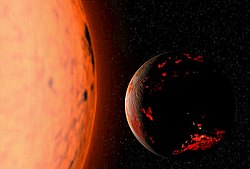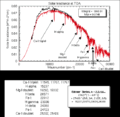is evidence that the formation of the Solar System began about 4.6 billion years ago with the gravitational collapse of a small part of a giant molecular...
113 KB (13,512 words) - 00:41, 20 June 2025
The history of scientific thought about the formation and evolution of the Solar System began with the Copernican Revolution. The first recorded use of...
57 KB (7,872 words) - 16:23, 15 February 2025
Exploration of Uranus Exploration of Neptune Exploration of Pluto Solar System models Formation and evolution of the Solar System – Nebular hypothesis Terrestrial...
12 KB (1,050 words) - 20:19, 24 October 2024
Sun (redirect from Solar diameter)
power. Solar activity is thought to have played a large role in the formation and evolution of the Solar System. Changes in solar irradiance over the 11-year...
173 KB (19,378 words) - 15:47, 16 June 2025
Ocean world (category Pages displaying short descriptions of redirect targets via Module:Annotated link)
proxy. The characteristics of ocean worlds provide clues to their history and the formation and evolution of the Solar System as a whole. Of additional...
55 KB (6,175 words) - 00:04, 8 May 2025
from the sun for a system to have Solar System belts. The Solar System belts were formed in the formation and evolution of the Solar System. The Grand...
13 KB (1,142 words) - 17:10, 19 March 2025
Chronology of the universe Far future in fiction Far future in religion Eschatology Formation and evolution of the Solar System Stability of the Solar System List...
178 KB (7,875 words) - 02:30, 20 June 2025
Creation of the world may refer to: Formation and evolution of the Solar System Cosmogony, any theory about the creation of the universe Creation myth...
784 bytes (138 words) - 05:20, 3 September 2024
The timeline of the universe begins with the Big Bang, 13.799 ± 0.021 billion years ago, and follows the formation and subsequent evolution of the Universe...
17 KB (2,026 words) - 01:56, 9 June 2025
the study of galaxy formation and evolution is concerned with the processes that formed a heterogeneous universe from a homogeneous beginning, the formation...
46 KB (5,624 words) - 04:13, 13 May 2025
extreme locations of the Solar System. Entries listed in bold are Solar System-wide extremes. List of Solar System objects most distant from the Sun Astronomy...
31 KB (1,740 words) - 20:19, 24 October 2024
are the largest impact craters on various worlds of the Solar System. For a full list of named craters, see List of craters in the Solar System. The ratio...
11 KB (304 words) - 03:52, 9 June 2025
Nebular hypothesis (redirect from The Solar Nebular Theory)
The nebular hypothesis is the most widely accepted model in the field of cosmogony to explain the formation and evolution of the Solar System (as well...
75 KB (9,180 words) - 00:49, 20 June 2025
There are eight planets within the Solar System; planets outside of the solar system are also known as exoplanets. As of 5 June 2025, there are 5,917 confirmed...
9 KB (813 words) - 17:27, 15 May 2025
ice rings of Saturn, and its diverse array of moons, and how they can reveal insights into the formation and evolution of the Solar System. He also explains...
16 KB (1,835 words) - 17:17, 11 May 2025
Protoplanetary disk (section Formation)
Formation and evolution of the Solar System Herbig–Haro object Nebular hypothesis Q-PACE – a spacecraft mission to study accretion Planetary system Johnathan...
22 KB (2,205 words) - 14:23, 28 May 2025
formed the Sun, but the planets acquired different compositions during the formation and evolution of the Solar System. In turn, the history of Earth led...
42 KB (4,386 words) - 20:20, 18 June 2025
theories and hypotheses about the formation and evolution of the Solar System gained by uncrewed missions to the planets. Originally released in the UK, it...
9 KB (332 words) - 15:12, 17 May 2025
Following are the longest, widest, and deepest rifts and valleys in various worlds of the Solar System. List of Solar System extremes List of largest craters...
7 KB (155 words) - 03:24, 6 May 2024
Nice model (category Solar System dynamic theories)
In astronomy, the Nice (/ˈniːs/) model is a scenario for the dynamical evolution of the Solar System. It is named for the location of the Côte d'Azur Observatory—where...
47 KB (5,838 words) - 13:05, 29 May 2025
with the sun directly overhead can vary from 550 W/m2 with cirrus clouds to 1025 W/m2 with a clear sky. Formation and evolution of the Solar System Irradiance...
13 KB (1,791 words) - 13:11, 18 June 2025
The Solar System is the gravitationally bound system of the Sun and the objects that orbit it. It formed about 4.6 billion years ago when a dense region...
224 KB (21,988 words) - 14:05, 14 June 2025
see: Timeline of the far future Chronology of the universe Timeline of the universe Formation and evolution of the Solar System Timelines of world history...
379 bytes (87 words) - 04:48, 31 January 2025
Venus and Jupiter were significant on whole solar tidal generating potential. Formation and evolution of the Solar System List of solar cycles List of solar...
90 KB (10,114 words) - 22:38, 16 June 2025
Meenakshi Wadhwa (category Fellows of the Explorers Club)
Wadhwa is a planetary scientist and educator who studies the formation and evolution of the Solar System through the analysis of planetary materials including...
7 KB (548 words) - 14:57, 23 December 2024
geological unit Formation of rocks, how rocks are formed Formation and evolution of the Solar System, history of the Solar System Rock formation, an isolated...
3 KB (474 words) - 11:17, 21 February 2025
below are the largest ocean, lakes and seas in the Solar System and beyond includes single bodies of water or other liquid on or near the surface of a solid...
22 KB (1,280 words) - 02:57, 2 June 2025
This is a list of the tallest mountains in the Solar System. This list includes peaks on all celestial bodies where significant mountains have been detected...
55 KB (4,006 words) - 16:06, 9 June 2025
planet's formation about 4.6 billion years ago (estimated 4567.30 ± 0.16 million years ago set by the age of the oldest solid material in the Solar System—protoplanetary...
33 KB (3,481 words) - 16:01, 23 May 2025
Jack G. Hills (category Fellows of the American Physical Society)
defended his thesis on the formation and evolution of the Solar System in 1969. His advisor was Richard L. Sears. He spent much of his professional career...
5 KB (347 words) - 19:21, 10 February 2025

















